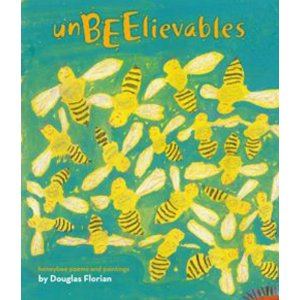1. Bibliographic Citation
Florian, Douglas. 2012. UnBEElievables: Honey Bee Poems and Paintings. New York: Beach Lane Books. ISBN 9781442426528
2.
Summary and Review
UnBEElievables
takes a poetic look at the fascinating lives of honey bees. Through a series of
poems about honey bees, Douglas Florian has created a fun and educational book about bees. The fourteen poems in this collection
range from poems about the different types of bees in the hive including drones,
workers, and the queen to bee anatomy and the disappearance of honey bees,
known as Colony Collapse Disorder. The poems are all rhyming and short, no
longer than one page, and each have a full page illustration on the facing
page. Florian’s signature style of paint and collage on paper bags continues
delight readers with hilarious illustrations of the queen bee with crown,
scepter, and cell phone and the drone brothers dressed in hip hop garb. The
collection also includes educational poem/illustration pairings such as “Bee
Anatomy” showing the honey bee body parts and “Bee-Coming” showing the honey
bee life cycle metamorphosis. Each page contains an interesting paragraph
explaining the scientific facts behind each poem. There is a “BEEbliography”
included at the end as well as URLs for further reading. I had the pleasure of
hearing Florian read some of these poems aloud at the TLA conference, and he did
a fun call and response with “Drone” and “Worker Bees.” What a treat to hear him
read his poetry! One of my favorite poems in the collection, “Bees Buzz,” makes
fun use of onomatopoeia, repetition, and rhyme:
Bees Buzz
All day we bees
Just buzz and buzz.
That’s what we duzz
And duzz and duzz.
Why are we full
Of fuzz and fuzz?
Bee-cuzz bee-cuzz
The fuzz the fuzz
Helps pollen stick
To uzz to uzz.
3.
Awards/Reviews
*Positive Reviews in School Library
Journal, Kirkus Reviews, The Horn Book, and Publishers Weekly
4.
Activities
Being so grounded in scientific fact, this
book can be used in conjunction with science. I, myself, learned so much about
honey bees while reading it. I would divide the class into three groups -
workers, drones, and queens. After reading their respective poems in the book
and doing some further research, they would create adaptations of “bio poems”
about each type of bee. The poems could then be read to the class and/or posted
in the hall. To make it even more fun, the library could hold an “UnBEElievable”
fun day in which students could dress up as bees and read Florian’s poems to
one another or to other classes. They could also do some research on Colony
Collapse Disorder and provide facts on what can be done to help. Educational
and fun!
5.
Related books
*Insectlopedia
by
Douglas Florian ISBN 9780152163358
*The
Beautiful Bee Book by Sue Unstead ISBN 9780769644288
*The
Beeman by Laurie Krebs ISBN 9781846862601






